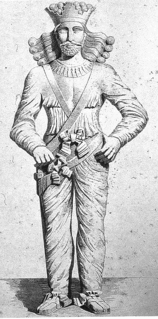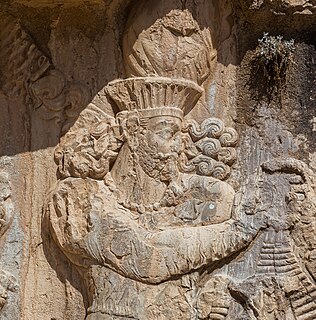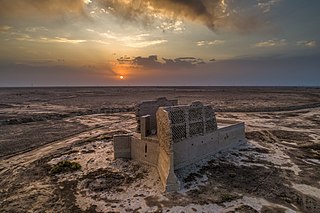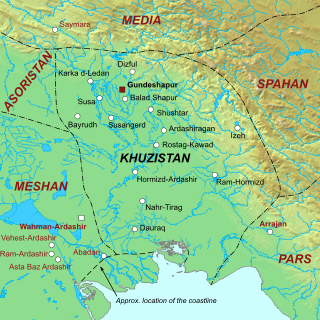
Shapur "Sakanshah" was a Sasanian prince who served as the governor of Sakastan under his brother king (shah) Shapur II (r. 309–379).

Shapur "Sakanshah" was a Sasanian prince who served as the governor of Sakastan under his brother king (shah) Shapur II (r. 309–379).
Shapur served as the governor of Sakastan–a province far away from the imperial court in Ctesiphon, and had since its conquest by Ardashir I (r. 224–240), served as a difficult area for the Sasanians to maintain control over. [1] As a result, the province had since its early days functioned as a form of vassal kingdom, ruled by princes from the Sasanian family, who held the title of sakanshah ("king of the Saka"). [1] Although native Sakastani soldiers had helped Shapur II in his wars against the Romans, they were probably mercenaries, and the province still remained relatively decentralized. [1] In 311, while Shapur was travelling from Sakastan to Istakhr, a city in Pars, he stopped at the ruins of the ancient Achaemenid capital of Persepolis, and had an inscription carved at the Tachara, the former palace of Darius the Great. [2]

Hormizd II was king (shah) of the Sasanian Empire. He ruled for seven years and five months, from 303 to 309. He was a son and successor of Narseh.

Hormizd III, was the seventeenth king (shah) of the Sasanian Empire, ruling briefly from 457 to 459. He was the son and successor of Yazdegerd II. His reign was marked by the rebellion of his younger brother Peroz I, who with the aid of one the Seven Great Houses of Iran, the House of Mihran, and the eastern neighbours of the Sasanians, the Hephthalites, had him captured and executed.

Bahram II was the fifth Sasanian King of Kings (shahanshah) of Iran, from 274 to 293. He was the son and successor of Bahram I. Bahram II, while still in his teens, ascended the throne with the aid of the powerful Zoroastrian priest Kartir, just like his father had done.

Bahram III, was the sixth king (shah) of the Sasanian Empire. He was son and successor of Bahram II. He was appointed viceroy to the province of Sakastan after Bahram II's re-conquest of it sometime in the 280s.

Bahram IV, was the Sasanian King of Kings of Iran from 388 to 399. He was likely the son and successor of Shapur III.

Shapur I, also known as Shapur the Great, was the second Sasanian King of Kings of Iran. The dating of his reign is disputed, but it is generally agreed that he ruled from 240 to 270, with his father Ardashir I as co-regent until the death of the latter in 242. During his co-regency, he helped his father with the conquest and destruction of Arab city of Hatra, whose fall was facilitated, according to Islamic tradition, by the actions of his future wife al-Nadirah. Shapur also consolidated and expanded the empire of Ardashir I, waged war against the Roman Empire and seized its cities of Nisibis and Carrhae while he was advancing as far as Roman Syria. Although he was defeated at the Battle of Resaena in 243 by Roman emperor Gordian III, he was the following year able to win the Battle of Misiche and force the new Roman Emperor Philip the Arab to sign a favorable peace treaty that was regarded by the Romans as "a most shameful treaty".

Ardashir II, was the Sasanian King of Kings of Iran from 379 to 383. He was the brother of his predecessor, Shapur II, under whom he had served as vassal king of Adiabene, where he fought alongside his brother against the Romans. Ardashir II was appointed as his brother's successor to rule interimly till the latter's son Shapur III reached adulthood. Ardashir II's short reign was largely uneventful, with the Sasanians unsuccessfully trying to maintain rule over Armenia.

Narseh was the seventh Sasanian King of Kings of Iran from 293 to 303.

Sakastan was a Sasanian province in Late Antiquity, that lay within the kust of Nemroz. The province bordered Kirman in the west, Spahan in the north west, Kushanshahr in the north east, and Turan in the south east. The governor of the province held the title of marzban. The governor also held the title of "Sakanshah" until the title was abolished in ca. 459/60.

Papag, was an Iranian prince, who ruled Istakhr, the capital of Pars, from 205/6 till his death sometime between 207–10. He was the father of Ardashir I, the founder of the Sasanian Empire. He was succeeded by his eldest son Shapur.

Sistān, known in ancient times as Sakastān, is a historical and geographical region in present-day Eastern Iran and Southern Afghanistan. Largely desert, the region is bisected by the Helmand River, the largest river in Afghanistan, which empties into the Hamun Lake that forms part of the border between the two countries.

The Azadan were a class of Iranian nobles. They are probably identical to the eleutheroi mentioned in Greek sources to refer to a group of Parthian nobles. According to the 1st-century Romano-Jewish historian Josephus, the Parthian army led by prince Pacorus I during the invasion of Judea consisted of members of the eleutheroi. The Kingdom of Armenia adopted the same hierarchy as that of the Parthians, which included the azadan class (azat), which was used to label the Armenian middle and lower nobility. The name of the Georgian nobility, Aznauri, also corresponded to that of azadan. A class of azadan are also attested in Sogdia, an Iranian civilization located in Central Asia.
Hormizd of Sakastan was a Sasanian prince who was the leader of a revolt in Sakastan and its surrounding regions. He was the son of Shapur Mishanshah, a Sasanian prince who governed Maishan, and was the son of the Sassanian shah Shapur I. Hormizd's mother was a certain queen named Denag. Hormizd had many other siblings named Hormizdag, Odabakht, Bahram, Shapur, Peroz, and Shapurdukhtak. In 260, his father died and was probably succeeded by Denag as the governor of Maishan. In 274, he was appointed as the governor of Sakastan and its surrounding regions. Three years later, when his cousin Bahram II ascended the throne, Hormizd's sister Shapurdukhtak married the latter. In ca. 281, Hormizd revolted against Bahram II, and was supported by the inhabitants of Eastern Iran, including the inhabitants of Gilan. Hormizd's revolt was finally suppressed in 283, and he was shortly executed under the orders of Bahram II, who appointed his own son Bahram III as the governor of Sakastan.

Shapur I's Ka'ba-ye Zartosht inscription, also referred to as The Great Inscription of Shapur I, and Res Gestae Divi Saporis (RGDS), is a trilingual inscription made during the reign of the Sasanian king Shapur I after his victories over the Romans. The inscription is carved on the Ka'ba-ye Zartosht, a stone quadrangular and stepped structure located in Naqsh-e Rustam, an ancient necropolis located northwest of Persepolis, in today's Fars Province, Iran. The inscription dates to c. 262.
Sakanshah was the title used by the rulers of Sakastan, first appearing during Surenid rule. The title was also used by the governors of Sakastan and Turgistan during the Sasanian era. However, during the early reign of king Peroz I, the title was abolished.

Kirman was a Sasanian province in Late Antiquity, which almost corresponded to the present-day province of Kerman. The province bordered Pars in the west, Abarshahr and Sakastan in the northeast, Paradan in the east, Spahan in the north, and Mazun in the south. The capital of the province of Shiragan.

Hormizd I Kushanshah was Kushanshah of the Kushano-Sasanian Kingdom from 275 to 300. His reign was marked by his rebellion against his brother and suzerain the Sasanian King of Kings Bahram II.

Shapur was an Iranian prince, who was the penultimate King of Persis from 207–210 to 211/2. He was succeeded by his younger brother Ardashir I, who founded the Sasanian Empire.

The Kings of Persis, also known as the Darayanids, were a series of Persian kings, who ruled the region of Persis in southwestern Iran, from the 2nd century BCE to 224 CE. They ruled as sub-kings of the Parthian Empire, until they toppled them and established the Sasanian Empire. They effectively formed some Persian dynastic continuity between the Achaemenid Empire and the Sasanian Empire.

Khuzistan or Huzistan was a Sasanian province in Late Antiquity, which almost corresponded to the present-day province of Khuzestan. Its capital was Gundeshapur. During the late Sasanian era, the province was included in the southern quadrant (kust) of Nemroz.